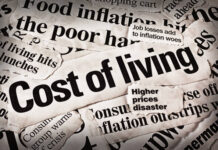Personal income growth accelerated to 0.3% month-on-month (m/m) in February, from 0.6% m/m in January, but above market expectations for a more modest gain of 0.2% m/m. Compensation of employees (+0.3% m/m) accounted for most of the growth.
Subtracting inflation and taxes, real personal disposable income rose 0.2% m/m in February, slowing from an upwardly revised reading of 1.5% in January. January’s outsized gain was largely driven by an assumption of lower expected capital gains taxes.
Personal consumption gained 0.2% on the month, from an upwardly revised reading of 2.0% m/m in January. This was lower than 0.3% increase expected by the consensus. Services spending rose by 0.2% m/m while goods were flat.
- Within services, increases in housing and health care were partly offset by a decrease in food services and accommodation.
- Within goods, increases in gasoline and other energy goods, “other” nondurables (led by pharmaceuticals), and food & beverage were offset by a decrease in motor vehicles and parts (mainly new and used light trucks).
Adjusting for inflation, real spending fell 0.1% m/m, on par with the consensus estimate. Both goods and services declined by 0.1% in real terms in February. Perhaps speak to the revisions though as they appear meaningful.
The personal consumption price deflator rose 0.3% m/m, and 5.0% on a year-on-year (y/y) basis – slightly lower than the expected 5.1% y/y reading and slower than 5.4% y/y reading in January.
The Fed’s preferred measure of inflation – core PCE – rose 0.3% m/m (vs. 0.4% consensus forecast) from a downwardly revised 0.5% m/m in January, decelerating to 4.6% year-on-year (from 4.7% in January). This was on par with market expectations.
The personal saving rate was 4.6% in February, just a notch below the 4.7% reading in January.
Key Implications
The first quarter’s spending is still tracking strong, at roughly a 4% (annualized) pace, but this impressive pace is mostly driven by revisions. It appears that January’s weather-induced spending impulse has faded. Today’s tepid growth is borderline flat and could be erased with revisions and a negative print in March. In any case, we expect consumer spending to slow in the second quarter. It’s too early to tell whether the bank turmoil will result in a further tightening of consumer credit, but judging by metrics as recent as February, consumers will face some headwinds as lenders have already reduced credit availability.
Inflation is still running hot, and the Fed will only see one more reading before they next meet in May. Provided there’s no further contagion across the banking sector, and market sentiment remains more even keel, we suspect the Fed will push ahead with one more 25 basis-point rate hike in May before pausing to better gauge the cumulative impact of its tightening.











